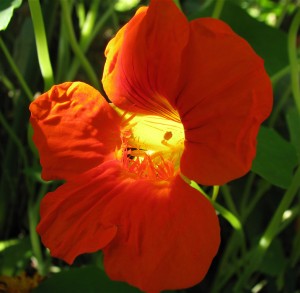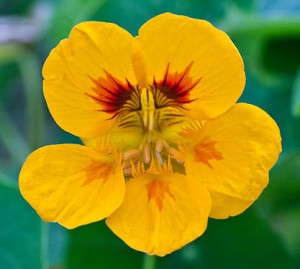Florid Appetizers
Posted in Exhibitions, Gardening Tips on April 9 2012, by Matt Newman
 Your vanity garden is scarcely the first place you look for salad toppings. Instead, most turn to the leafy standbys–lettuce, cabbage, kale, spinach. Throw in a few slices of zucchini or a handful of cherry tomatoes, maybe sprinkle the bowl with a few herbs to push the salad toward “exotic.” But what if I told you that eating the florid, elegant blooms that might otherwise end up in a vase is as natural as dousing your Caesar with dressing?
Your vanity garden is scarcely the first place you look for salad toppings. Instead, most turn to the leafy standbys–lettuce, cabbage, kale, spinach. Throw in a few slices of zucchini or a handful of cherry tomatoes, maybe sprinkle the bowl with a few herbs to push the salad toward “exotic.” But what if I told you that eating the florid, elegant blooms that might otherwise end up in a vase is as natural as dousing your Caesar with dressing?
I’m not saying you should go right out and make a trial-and-error buffet of your window planter. There are only certain flowers that you would have any desire to eat, as many are poisonous or taste beyond awful. And that’s all the disclaimer I can give: don’t eat anything unless it is properly identified.
Plenty of flowers have already made a name for themselves in the culinary nomenclature; mint, lilac, lavender, jasmine–they tend to find a home in teas. But what about snacking fare? TreeHugger recently put together a collection of the delicious, dainty, and downright delectable flowers of the gardening scene that could make their way onto your plate with minimal preparation.
For our purposes we focus on a heavy-hitter in the middle of the list, the nasturtium, a favorite of Impressionist Claude Monet and a regular on international dinner tables. The brilliant flowers and rich green foliage are entirely edible, and offer what TreeHugger calls a “sweet, floral flavor bursting with a spicy pepper finish.” More than a simple garnish, nasturtium flowers and seed pods have found their way into traditional stir-fry dishes, pickling jars, and hors d’oeuvre platters.
 It’s doubtful Monet was ever caught stuffing his face along the walks of his garden, Giverny–certainly not with his own nasturtiums. As an aesthetic choice, the flowers overflowing along the main path of the Impressionist’s French sanctuary were carefully selected, as was everything else in the botanical paradise that inspired so much of the painter’s work. But unlike the perfect disc configurations of his water lily pond, or the carefully shaped stands of irises, the nasturtiums were a rare product of unintentional trial and error.
It’s doubtful Monet was ever caught stuffing his face along the walks of his garden, Giverny–certainly not with his own nasturtiums. As an aesthetic choice, the flowers overflowing along the main path of the Impressionist’s French sanctuary were carefully selected, as was everything else in the botanical paradise that inspired so much of the painter’s work. But unlike the perfect disc configurations of his water lily pond, or the carefully shaped stands of irises, the nasturtiums were a rare product of unintentional trial and error.
Monet’s decision to soften the edges of his central allée with nasturtiums led him to a dwarf variety which suited his original purposes. He wanted subtlety. Unfortunately, the flowers he went home with weren’t dwarf nasturtiums at all, but a rambling variety that quickly tumbled over the borders of the path, spilling into the main walkway. The unchecked flood of rich foliage and flowers, contrary to what Monet had initially intended, proved a fortunate mistake–he insisted on a similar planting of unruly nasturtiums in the years that would follow.
Of course, there’s no need to jet across the Atlantic to see the flowers that so inspired Monet. Visit the NYBG beginning May 19 to experience an homage to Giverny in New York City, with rarely-seen works of art from the Impressionist master himself. And this advice is sound: don’t make a sample tray of anyone else’s garden without permission (especially while visiting Giverny, unless you plan on spending an awkward night in lockup with the gendarme).
Monet’s Garden opens May 19 and welcomes visitors through October 21, with rarely-seen gallery exhibits, stunning recreations of the gardens at Giverny, and a focus on the artistry of the great Impressionist. Be sure to reserve tickets.
Photos courtesy of Wikimedia Commons.

